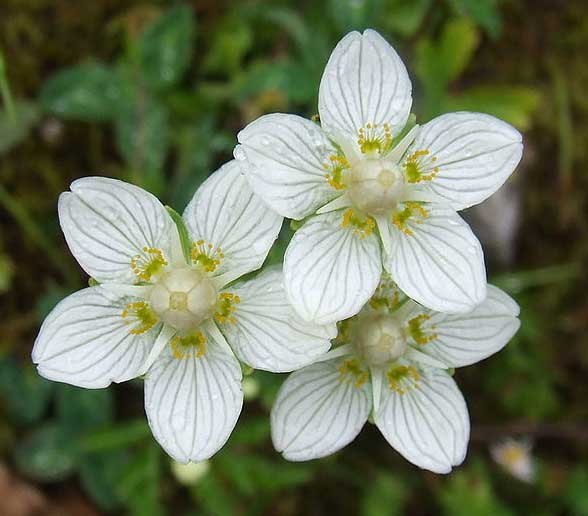
Parnassia palustris (*)
Classification System: APG IV
Superregnum: Eukaryota
Regnum: Plantae
Cladus: Angiosperms
Cladus: Eudicots
Cladus: Core eudicots
Cladus: Rosids
Cladus: Eurosids I
Ordo: Celastrales
Familia: Celastraceae
Subfamilia: Parnassioideae
Genus: Parnassia
Sectio: P. sect. Parnassia
Species: Parnassia palustris
Varietates: P. p. var. izuinsularis – P. p. var. montanensis – P. p. var. parviflora – P. p. var. tenuis – P. p. var. yakusimensis
Name
Parnassia palustris L., Sp. Pl. 1: 273 (1753).
Type: Europe. Herb. Burser XVII: 91, vide Hultgård (1987).
Synonyms
Enneadynamis polonorum Bub.
Parnassia alpina Dalla Torre
Parnassia ciliata Gilib.
Parnassia europaea Pers.
Parnassia mucronata Sieb. & Zucc.
Parnassia obtusiflora Rupr.
Parnassia palustris f. nana T. C. Ku
Parnassia palustris subsp. obtusiflora (Rupr.) D.A.Webb
Parnassia palustris f. rhodanthera H. Ohba & Y. Umezu
Parnassia palustris var. syukorankeiensis Yamam.
Parnassia palustris f. ussuriensis Kom. ex Nekr.
Parnassia tenuis DC.
Parnassia vulgaris Dum.-Cours.
Distribution
Native distribution areas:
References
Primary references
Linnaeus, C. 1753. Species Plantarum. Tomus I: 273. Reference page.
Links
Hassler, M. 2019. Parnassia palustris. World Plants: Synonymic Checklists of the Vascular Plants of the World In: Roskovh, Y., Abucay, L., Orrell, T., Nicolson, D., Bailly, N., Kirk, P., Bourgoin, T., DeWalt, R.E., Decock, W., De Wever, A., Nieukerken, E. van, Zarucchi, J. & Penev, L., eds. 2019. Species 2000 & ITIS Catalogue of Life. Published online. Accessed: 2019 October 06. Reference page.
Govaerts, R. et al. 2019. Parnassia palustris in Kew Science Plants of the World online. The Board of Trustees of the Royal Botanic Gardens, Kew. Published online. Accessed: 2019 October 06. Reference page.
International Plant Names Index. 2019. Parnassia palustris. Published online. Accessed: October 06 2019.
Tropicos.org 2019. Parnassia palustris. Missouri Botanical Garden. Published online. Accessed: 06 October 2019.
USDA, ARS, Germplasm Resources Information Network. Parnassia palustris in the Germplasm Resources Information Network (GRIN), U.S. Department of Agriculture Agricultural Research Service.
Vernacular names
беларуская: Відомец балотны
català: fetgera blanca
kaszëbsczi: Dzewikwiat
čeština: tolije bahenní
Cymraeg: Brial y gors
dansk: Leverurt, Leverurt-slægten
Deutsch: Sumpf-Herzblatt, Sumpfherzblatt, Studentenröschen
English: grass-of-Parnassus, marsh grass-of-Parnassus, northern grass-of-Parnassus, bog-star
español: hepática blanca, parnasia
eesti: Harilik ädalalill, Ädalalill
suomi: Suovilukko, vilukko
français: Parnassie des marais, hépatique blanche
hornjoserbsce: Bahnowy jenačk
magyar: Fehérmájvirág
íslenska: Mýrasóley
italiano: Fiore del Parnasso
日本語: ウメバチソウ, Parnassiaceae, 梅鉢草, ウメバチソウ属, コウメバチソウ
lietuvių: Pelkinė mandrauninkė
latviešu: Purva atālene
norsk bokmål: Jåblom
Nederlands: Parnassuskruid, parnassia
norsk nynorsk: Jåblom
polski: Dziewięciornik błotny
русский: Белозор болотный, Золотничка болотная
саха тыла: Чэмэлиидэ
davvisámegiella: Beivečalbmi, Suotnjočalbmi
slovenčina: bielokvet močiarny, parnasia močiarna
slovenščina: Močvirna samoperka
svenska: Slåtterblomma, Hjärteblomma, Hjerteblomma
українська: Білозір болотний, Мудник, Маточник білий
中文: 梅花草
Parnassia palustris, the marsh grass of Parnassus, northern grass-of-Parnassus, or just grass-of-Parnassus,[1] and bog star,[2] is a flowering plant in the staff-vine family Celastraceae.[3]
It is the county flower of Cumberland in England, and appears on its flag.[4]
The name comes from ancient Greece: evidently the cattle on Mount Parnassus appreciated the plant; hence it was an "honorary grass".[5] The specific epithet palustris is Latin for "of the marsh" and indicates its common habitat.[6] It was described by the Greek physician Dioscorides, growing up a mountain in 1st century A.D.[7]
Description
This perennial plant is not a grass, nor does it look like one, but grows from a short underground stem. It has long stemmed heart-shaped leaves, which are 4-12 in (10–30 cm) long. In the centre of the leaf, is the flowering stem. The stem holds a solitary white flower, blooming between July and October. The flower has 5 stamens around the centre. The flower produces a honey-like scent to attract pollinators.[7]
Range and distribution
Parnassia palustris is native to northern temperate parts of Eurasia.[8] Found in wet moorlands and marshes of northern England and Scotland.[7]
Uses
Seen on Mount Ontake, Ōtaki, Nagano prefecture, Japan
It was once used in herbal medicines, to treat disorders of the liver. Also an infusion of the leaves, (similar to a tea) was used to treat indigestion. When added to wine or water, the leaves are claimed to dissolve kidney stones.[7]
History
While finishing his schooling in the School of Mines at Freiberg from June 14, 1791, to February 26, 1792, Alexander von Humboldt published three articles on plants in the Annalen der Botanik. These were his first of what the world famous explorer would produce. Notably, one was concerning "On the Motion of the Filaments of the Parnassia Palustris." [9]
References
BSBI List 2007 (xls). Botanical Society of Britain and Ireland. Archived from the original (xls) on 2015-06-26. Retrieved 2014-10-17.
"Parnassia palustris". Germplasm Resources Information Network (GRIN). Agricultural Research Service (ARS), United States Department of Agriculture (USDA).
"Plants Profile — Parnassia palustris L., marsh grass of Parnassus". U.S. Department of Agriculture — Natural Resources Conservation Service. Retrieved 3 February 2010.
"Cumberland Flag". Flag Institute. Retrieved 8 October 2017.
"Grass-of-Parnassus". Plantlife. Retrieved 10 December 2010.
Archibald William Smith A Gardener's Handbook of Plant Names: Their Meanings and Origins, p. 258, at Google Books
Press, J. R.; Sutton, Dr D. A.; Tebbs, B. M. (1981). Field Guide to the Wild Flowers of Great Britain. London: The Reader's Digest. p. 155.
Arne Anderberg. "Parnassia palustris L." Den Virtuella Floran. Naturhistoriska riksmuseet. Retrieved 6 September 2018.
von F. A. v. Humboldt. "Beobachtungen über die Staubfäden der Parnaflia paluftris" Annalen der Botanick. / Herausgegeben von Dr. Paulus Usteri. Drittes Stück. 1792 vol.3, p.7 Accessed Dec 21, 2021
Retrieved from "http://en.wikipedia.org/"
All text is available under the terms of the GNU Free Documentation License

